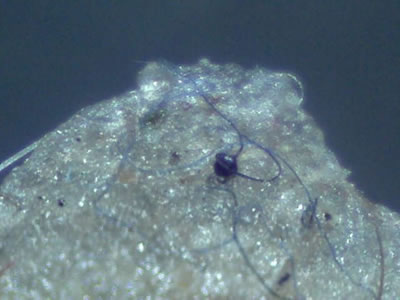Science Fiction
Dictionary
A B C D E F G H I J K L M N O P Q R S T U V W X Y Z
Morgellons Disease Has Science-Fictional Effects

Morgellons is characterized by red, blue or black filaments that emerge from skin lesions. The sufferer also feels itching and crawling sensations below the skin.
Morgellons was first named by Mary Leitao, a Pittsburg biologist who took the name from a centuries-old medical paper describing what may be a related illness.

(From Morgellon's disease in situ)
Dermatologists are skeptical; they see it as a form of delusional parasitosis and note that it can be associated with schizophrenia, obsessive behavior, bipolar disorder, depression and anxiety disorders.
The United States Centers for Disease Control (CDC) has contacted Kaiser Permanente Northern California to investigate the problem. The Armed Forces Institute of Pathology will also participate. The study will take at least 12 months to complete.
"The cause of this condition is unknown," said Dr. Michele Pearson, principal investigator with the CDC. "Those who suffer from this condition, as well as their families and physicians, have questions, and we want to help them find meaningful answers."
Last year, the CDC received about 1,200 inquiries about the disease from both patients and physicians. At present, the CDC refers to Morgellons as "unexplained dermopathy."
Here's a short video of some of the problems associated with Morgellon's Syndrome, with some close-ups of the disease presentation.
(From Morgellon's syndrome)
When I first read about this, I immediately thought about a purely science-fictional problem; intelligent lymphocytes taking over a person's body in Greg Bear's classic Blood Music:
In the dark, just as he was on the edge of sleep, his back began to crawl. He scratched abstractedly, then sat up in bed with a whispered curse...He turned and looked at himself in the bathroom mirror... His chest was splotchy and red from scratching and rubbing. He rotated and peered over his shoulder at his back.
From shoulder to shoulder, and criss-crossing down his spine, faint pale lines just beneath the surface of his skin drew a crazy and unwelcome road map...
Read more at CDC To Launch Study on Unexplained Illness - CDC press release and Study seeks clues on skin-crawling Morgellons syndrome.
Scroll down for more stories in the same category. (Story submitted 1/17/2008)
Follow this kind of news @Technovelgy.| Email | RSS | Blog It | Stumble | del.icio.us | Digg | Reddit |
Would
you like to contribute a story tip?
It's easy:
Get the URL of the story, and the related sf author, and add
it here.
Comment/Join discussion ( 5 )
Related News Stories - (" Medical ")
Natural Gait With Prosthetic Connected To Nervous System
'The leg was to function, in a way, as a servo-mechanism operated by Larry’s brain...' - Charles Recour, 1949.
Brain Implant Is Able To Capture Your Inner Dialogue
'So you see, you can hide nothing from me.'
'Pregnancy Humanoids' From China Replace Moms
'A great many of these synthetic babies were made...' - David H. Keller, 1928.
Bacteria Turns Plastic Into Pain Relief? That Gives Me An Idea.
'I guess there's nobody round this table who doesn't have a Crosswell [tapeworm] working for him in the small intestine.'
Technovelgy (that's tech-novel-gee!) is devoted to the creative science inventions and ideas of sf authors. Look for the Invention Category that interests you, the Glossary, the Invention Timeline, or see what's New.
Science Fiction
Timeline
1600-1899
1900-1939
1940's 1950's
1960's 1970's
1980's 1990's
2000's 2010's
Current News
Natural Gait With Prosthetic Connected To Nervous System
'The leg was to function, in a way, as a servo-mechanism operated by Larry’s brain...'
Woman Marries Computer, Vonnegut's Dream Comes True
'Men are made of protoplasm... Lasts forever.'
Spidery 'Walk Me' Toyota Autonomous Wheel Chair Like Star Wars
Walk along with the emperor.
Dancing Robots Taught Dance Moves
'A clockwork figure would be the thing for you...'
Proof Of Robothood - Not A Person
'Who are you people? - Show 'em.'
Indonesian Clans Battle
'The observation vehicle was of that peculiar variety used in conveying a large number of people across rough terrain.'
The 'Last Mile' In China Crowded With Delivery Robots
Yes, it's a delivery robot. On wheels.
Tornyol Microdrone Kills Mosquitoes
'The real border was defended by... a swarm of quasi-independent aerostats.'
PLATO Spacecraft, Hunter Of Habitable Planets, Now Ready
'I ... set my automatic astronomical instruments to searching for a habitable planet.'
Factory Humanoid Robots Built By Humanoid Robots
'...haven't you a section of the factory where only robot labor is employed?'
iPhone Air Fulfils Jobs' Promise From 2007 - A Giant Screen!
'... oblongs were all over the floor and surfaces.'
ChatGPT Now Participates in Group Chats
'...the city was their laboratory in human psychology.'
iPhone Pocket All Sold Out!
'A long, strong, slender net...'
Did The Yautja Have These First?
What a marvel of ingenuity the little device was!
Jetson ONE Air Races Begin, Can Air Polo Be Far Behind?
'If you're one of those rarities who haven't attended a rocket-polo "carnage", let me tell you it's a colorful affair.'
Will Space Stations Have Large Interior Spaces Again?
'They filed clumsily into the battleroom, like children in a swimming pool for the first time, clinging to the handholds along the side.'
